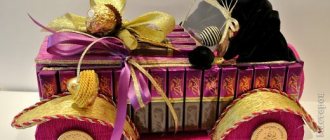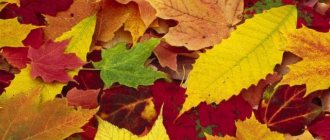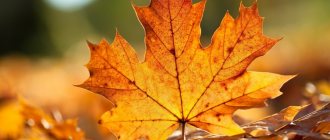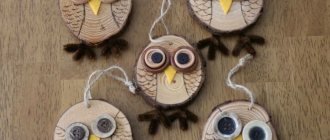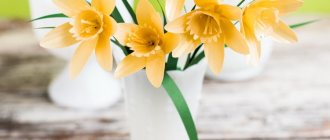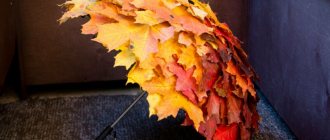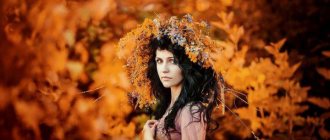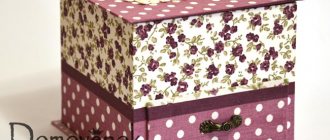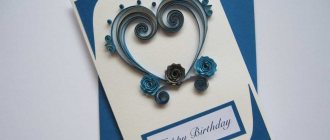Sequencing
A true artist sees living images in nature, so we can dream up our imaginations. Let’s lay out all our collected and dried wealth in front of us and see what it’s like. Take suitable leaves and place them on cardboard until you get a picture. There is no need to glue it yet, first just lay it out until you are happy with everything.
When the picture is perfect, you can glue it. We take one leaf at a time, remembering where it was, smear it on the back side, and glue it in place. If the application is multi-layered, first glue the lower leaves, then the top layer. The craft is ready! You can admire it!
But what if appliqué ideas just don’t come to mind, and the leaves only look like leaves, and not at all like bunnies and chanterelles? Then take advantage of our ideas.
Leaf craft ideas
Applications with animals
Owl made of leaves:
Red cat
Bird with chicks:
And even an eagle:
Landscapes of leaves
For a landscape, the background can be painted with watercolors.
Still lifes
Portraits
The finished application (if it is not voluminous) can be placed under a press so that after drying it remains flat. Store in a dry place, perhaps in a frame under glass.
People often wonder what is the best way to glue tree leaves onto paper. For this purpose, different compositions are used. Silicate glue, PVA, transparent or hot substance are highly effective. It is also permissible to use a glue stick or make a natural composition based on starch. To achieve good results, you should think through all the details of the craft in advance.
It is possible to glue tree leaves onto paper using different compositions. To achieve good results in this, you need to choose the right substance.
Starch paste
This substance is well suited for leaf applications. The adhesive composition is considered completely safe. It is allowed to be used by allergy sufferers. The substance has excellent adhesive characteristics and helps attach foliage to paper and cardboard.
The paste can be applied with a sponge or brush. To get rid of smudges, use a dry sponge or napkin. As the substance dries, it acquires a transparent consistency.
PVA glue for applications
This is a popular composition that can be used by children and adults. Using PVA you can create interesting compositions on paper, textiles or cardboard. After drying, the substance does not leave stains and does not acquire a yellow tint.
The substance can be thick or liquid.
Transparent glue for decoupage
This substance combines the properties of glue and varnish. It can be used for making three-dimensional crafts - vases, lamps and other items. After the substance dries, a protective layer appears on the craft. The composition fixes foliage well on glass or wood.
Hot glue
This product is used for large autumn crafts. It creates a certain danger during operation. The glue gun reaches high temperatures and can cause burns. At the same time, it allows you to fix foliage on different materials. After hardening, the substance acquires a white-transparent tint. That’s why they hide it inside the structure.
Super glue
This substance is often used by adult craftsmen. However, it poses a danger to children. The product has a strong odor and causes allergies. If used carelessly, there is a risk of sticking your fingers. The composition dries quickly and sets easily.
Silicate
This substance has many advantages. It helps securely fix parts and is economical. The substance dries quickly and can be easily washed off with water. When choosing silicate glue, you should consider its consistency. The high-quality composition has a transparent texture and does not contain lumps or clots.
Glue stick
The most popular and affordable composition is considered to be glue in the form of a pencil. It is easy to use due to its compact capacity. The substance is characterized by a dense consistency, so it is used very sparingly. With the help of the product it is possible to glue paper and cardboard, as well as textiles.
How to glue leaves - on paper and crafts
Crafts with leaves or professional panels are relevant for creativity in the summer and autumn.
To properly glue dried leaves, you need the right glue. In this article we will look at what glue to use to glue leaves when working with paper, cardboard, fabric, for gluing three-dimensional crafts, for professional gluing.
What glue to use to glue tree leaves
Due to the variety of techniques for making compositions with leaves, adhesive compositions are used that correspond to the substrate and the amount of work.
- Potato starch craft paste - ideal for children's leaf appliques.
Completely safe adhesive, suitable for allergy sufferers, has good adhesive properties, and is equally ideal for paper and cardboard.
With this glue, even a small child can make a craft from leaves on his own, and the parent will not have to constantly monitor the progress of the work.
The paste can be applied with a brush or sponge. Smudges of adhesive mass from the application can be easily removed with a napkin or a dry sponge.
After drying, the paste becomes transparent, which is especially important when gluing dry leaves to paper.
- PVA glue for leaf applications is a well-known material. For younger children, choose a children's composition; adults can use professional PVA glue from a construction supermarket.
This glue can be used to create panels and appliqués on paper, cardboard and fabric. After drying, PVA leaves no traces and does not turn yellow.
The composition can be liquid or thick, while the latter is more convenient to work with.
- Transparent glue for decoupage from leaves - a store-bought composition that combines glue and varnish - two in one.
With this glue you can make three-dimensional crafts from dry leaves and plants: vases, lamps and other interesting decorative crafts.
After the adhesive mass dries, a protective layer will be created on top of the craft, since during operation this glue is applied as a substrate for gluing and a final coating for improved adhesion.
The glue works well on glass, wood, napkins and on top of leaves.
- Hot glue for voluminous crafts made from dry leaves - when making large autumn crafts - baskets, wreaths, autumn-themed compositions and other works.
Hot glue is somewhat dangerous when working, as it requires extreme care, because the glue gun gets very hot and can cause burns.
Otherwise, this is an ideal glue to which you can apply leaves or dry plants for gluing; sticks and leaf cuttings can be inserted into the glue to obtain volume. Using a glue gun, you can glue leaves to any material.
After hardening, the composition becomes white-transparent in color, and therefore it must be hidden inside the craft or applied in a very small amount so that it is unnoticeable.
- Superglue is held in high esteem by adult craftsmen, but is dangerous for children: it has a chemical odor of cyanoacrylate that irritates the mucous membranes, can cause allergies or chemical burns to the eyes when working for a long time; if used carelessly, there is a risk of sticking your fingers together - and it will be extremely difficult and painful to separate them .
The disadvantage and simultaneous advantage is the speed of drying, the glue sets quickly and it will be impossible to correct an unsuccessfully glued leaf.
VIDEO INSTRUCTIONS - HOW TO GLUE LEAVES
kakkley.ru
Performing skeletonization
An interesting technique is skeletonization. It is characterized by certain features.
What you will need
To achieve good results in this, it is important to prepare everything you need.
Fresh leaves
First of all, you should prepare fresh foliage. The material is chosen depending on your preferences.
Soda
This substance is used to prepare a solution.
Egg dye
Small capacity
To prepare the coloring solution, you will need a container of a suitable size.
Toothbrush
Paper napkins
Using paper napkins you can remove excess moisture from the surface of the leaves.
How to perform the procedure
- Pour 1 tablespoon of soda into the pan and pour in 4 tablespoons of water.
- Mix thoroughly and place the leaves in a container.
- Boil for half an hour over low heat.
- Place the foliage with the glossy side up and blot with a napkin.
- Clean the pulp with a toothbrush.
- Make a dye solution.
- Dip the leaves into the liquid.
- Remove and dry the material.
How to Skeleton Leaves
Leaf skeletons, due to their lightness and transparency, look very impressive as decoration. To achieve this effect, you need to resort to a special technique - skeletonization.
What you will need:
- any fresh leaves;
- soda;
- egg dye;
- small container - ladle or pan;
- Toothbrush;
- paper napkins.
How to make skeletonized leaves:
- Mix soda and water in proportions of 1 to 4 and place the leaves in the prepared solution so that they are completely hidden by water.
- Bring the mixture to a boil and leave to simmer for 30 minutes.
- Remove the pan from the stove and remove the leaves, carefully placing them on the table with the glossy side up.
- Remove excess moisture using napkins.
- Clean the pulp from the leaf with a brush (this must be done very carefully, the leaves are quite fragile).
- Rinse the skeleton under water and then paint it the desired color.
- Leave the painted skeletonized leaves to dry.
The resulting material is ready for use.
Craft options
Today there are many options for crafts that have excellent decorative properties.
Topiary
Maple leaves are perfect for making topiary. To do this, it is recommended to fix a stick in the pot. This is done using gypsum mortar. Attach spherical foam rubber and stick leaves into it. Berries, beads, and ribbons are suitable as decoration. A hot glycerin solution will help make the leaves stronger.
Bouquet
To make a beautiful bouquet, you should bend the maple leaves in half and roll them into a tight tube. Then make a rosebud out of it and secure its base with thick threads. Make the required number of roses and secure them to tree sticks.
Decorative autumn wreath
Bright fall leaves can be used to make a beautiful wreath. For this you will need flexible branches, dried foliage of various shades, and red berries.
It is worth making a frame from the branches and securely fixing it with threads. Glue leaves and berries to the branches.
It is permissible to use physalis or birds as decoration.
Vase of leaves
First you need to inflate the balloon and lubricate it with Vaseline. Fix the product motionless and glue the maple leaves. To make a vase durable, you should use several layers of material. Finally, coat the product with glue and leave to dry for 3 days. Pop the ball and get rid of the rest.
Photo frame
To begin with, you should cut out a frame from cardboard and leave a place in the center for the photo. Soak the leaves in hot water and glue them in the frame. Wait until it dries and insert the photo into the center. It can be secured with tape.
Applications from autumn leaves
To make a beautiful applique, you should use foliage of different sizes and shapes. A whole series of paintings looks interesting.
Owl
To make an owl you will need dry leaves, cardboard, and colored paper. First you need to cut out a bird from cardboard. Then glue the leaves that will represent the ears and paws. Willow leaves are suitable for feathers. The eyes and beak should be cut out of colored paper.
Firebird
To begin with, you should glue a linden leaf - it will represent the body. The head should be made from a birch leaf. To get a beautiful tail, you should glue rosehip leaves. Pumpkin seeds are used to make eyes and body decorations. A thuja branch is suitable for a tuft.
a lion
To begin with, you should draw the head of a lion on yellow paper. To make a mane, you should stick on linden leaves. Then draw the nose and glue the chestnut. Pine needles are used for the mustache, and ash seed is used for the tongue.
Fish
To begin with, you should put an image of a fish on blue paper and cut it out. Make scales from linden leaves and glue them to the body. Decorate the tail with brown quince leaves. Caps of acorns will help make the outline of the head.
Alphabet
For children who are just starting to learn letters, you can make an alphabet from autumn leaves. This will help your baby remember the alphabet faster.
Stained glass
To begin, cut off the required amount of self-adhesive tape and place it with the sticky side up. Then place the hoop and leaves. Place another piece of film on top, press and smooth. Insert the outer part of the hoop and tighten it. Get rid of excess film.
To hang the product on the wall, use twine.
Garland
To begin with, the leaves should be cleaned and dried, removing the cuttings. Place wax paper on the table and secure the ends of the fishing line with masking tape. Lay out the foliage and glue it to the fishing line. Once dry, the tape can be removed.
Ikebana
First you need to dry the aspen leaves. To create a blank, you need to inflate a ball, lubricate it with an aqueous solution of PVA and wrap it with thread. Then the ball should be deflated and pulled out. After this, make roses from aspen leaves and attach them to a ball of thread. Use rowan and dried flowers as decoration.
Panel
This composition will require autumn leaves. It's also worth taking a board, marker and glue. The foliage should be dried. Draw a maple leaf on the board and lay it out using dried material.
Collage
To do this, you should chop up the foliage, apply a tree trunk to the cardboard and paint it. Then treat the trunk and branches with glue and sprinkle with leaf crumbs.
Landscapes
To create an interesting landscape, you can take cardboard and make a picture using dry foliage. The background can be painted with watercolors.
Interesting ideas and examples of work
Interesting solutions include creating a rooster or a peacock. This material can also be used to create vases with flowers, trees, and fruit baskets. Different animals look interesting - donkey, elephant, fox.
A simple option for kids would be to make an aquarium. To do this, you should take blue cardboard and small leaves that are shaped like fish. A mixture of buckwheat and peas will help to depict pebbles.
You can use different materials to fix leaves on paper. To achieve good results, you should strictly follow the technique of making crafts.
1. Small or medium-sized leaves are more suitable for crafts. As well as all kinds of berries (for example, rowan), dried flowers, seeds and herbs, spices that any housewife has in her kitchen (peppercorns, allspice and cloves). To highlight the details of the application and its background, you can use pencils, felt-tip pens and paints.
2. Before making the leaf applique,
prepare materials for crafts. Leaves collected from a forest or park must be thoroughly dried. To do this, simply iron them with a warm iron, having previously lined them with paper on both sides. After this, remove the top layer of paper and let the leaves dry completely.
True, this method of preparing leaves is not suitable if you are making an application with a small child. Still, such fragile material as dry leaves is more suitable for older children. The little ones will literally crumble the leaves in their hands. In this case, it is better to make the application from undried leaves, and then dry the finished composition.
3. Before gluing the leaves onto cardboard or a sheet of paper, make a barely noticeable pencil sketch of the future application on it. This way, the child will better imagine the future composition and more accurately glue the appliqué details to the paper.
4. As for glue, ordinary stationery glue will do, which needs to be applied to the piece of paper in a very thin layer or dripped with liquid glue in several places on the piece of paper.
5. You can start making the simplest applications with a one and a half year old baby, gradually complicating the plot.
Drying in a book
Even a child can use this method. He will need an old thick book and beautiful autumn leaves. They can be picked up from the ground or torn directly from a tree. It is important that they are free of any defects - holes, rotting areas, tears.
Hyundai's Kona N: the first performance crossover with 275 hp
In Chechnya they decided to dub Soviet cartoons into their native language
August is for Gemini: the luckiest months in 2021 for each sign
It is better to take an old book that is no longer useful. The fact is that during the drying process the sheet releases the juice present in it, which stains the pages. You can also use a stack of last year's newspapers. You just need to make sure that they do not change their position while the leaf dries. Otherwise, it may become deformed or crumble into small pieces. The sheet must be placed between the pages. It is important that it is pressed down well. If this is not done, it may rot.
If there are no unnecessary books in the house, take any. Only in this case, place paper towels or napkins on the top and bottom of the leaf. They will absorb the juice that is released, and the pages of the book will remain clean. If you have several pieces of paper, arrange them so that there are at least 40 pages between them. Then they will not deform each other during the drying process. You need to wait 2-3 weeks.
This method is good for its simplicity. With its help you can dry any leaves that fit in the book. However, at the same time they become faded and not so beautiful. In addition, leaves dried in a book turn out to be very fragile. They break easily from a careless touch. They can be used for herbarium or creating applications. In a bouquet they do not look very impressive.
Numerological forecast for 2021: find out your fate by date of birth
Biologists could explain the sharp increase in biodiversity of the Cambrian explosion
Why Covid is spreading: we don’t follow measures with our friends
How to make an applique from leaves
1. Outline the location of the future application with a simple pencil.
2. Take the prepared leaves. They must be taken with caution. Teach your baby to do this using tweezers or one finger dipped in water.
3. Now you need to glue the leaves to the cardboard. If the leaves are not too dry, then apply glue directly to them, and if they are dried, then cover the surface of the cardboard with glue.
4. After the application is completely ready, cover it with a napkin and place it under a load (for example, under a stack of books) for a day.
In the microwave
This method is also very simple. The good thing about it is that you can get the material for crafts in just a few minutes. A microwave comes in handy if a kindergarten or school suddenly requires you to bring a herbarium urgently.
Despite its apparent simplicity, there is no need to entrust a child with drying the leaves in this way. The fact is that the drying process should only take a couple of minutes. If the sheet is left in the oven, it will turn black and wrinkle. It is difficult for a small child to count down the required time, so it is advisable that an adult do this work.
Before putting the leaves in the microwave, you need to remove moisture (if any) from them. You can dry several leaves at the same time in the oven. To prevent them from sticking together, do not place them next to each other. There should be a small distance between the sheets.
You need to place them on a paper towel folded in two layers. Cover the top with another layer of paper. Carefully place this structure in the microwave and turn on the device for 30 seconds. During this time, the leaf will not have time to become completely dry. Therefore, you will then need to turn on the oven several times for 5 seconds. The maximum amount of time a sheet should spend in the microwave is only 3 minutes. If you leave it too long, it may even catch fire. That is why such work must be done by an adult.
DIY note board: looks impressive and reminds you of what’s important
Singer Aziza showed her Italian lover for the first time
Large-scale lockdown: foreigners are completely banned from entering Japan
If you really need it, the leaves prepared in this way can be used immediately. However, it is better to give them a little more time for final drying. After microwaving, place them in a dark place overnight. It's even better if they dry for a day or two.
If you notice that the sheets are becoming faded, immediately treat them on both sides with acrylic spray.
Leaf applications: ideas
For kids
Simple stories are suitable for the little ones. Ask your child to use leaves to build everything he saw during his walk, for example, trees. Help him glue small leaves (birch or aspen) to a landscape sheet or cardboard, and draw the branches and trunk with paints or felt-tip pens.
Children 3-4 years old
For older children, you can complicate the task by thinking about what or who this or that leaf looks like. You can not only make some kind of animal or bird, but also create a whole plot, for example, a bird sitting on a branch or a cute hedgehog with mushrooms on its back.
For preschoolers
With preschoolers you can make applications from leaves
several trees at once (aspen, birch, maple, rowan). These can be simple compositions of one figure, or more complex ones, consisting of several figures. From multi-colored leaves you can make a beautiful card, a bookmark, or something else useful.
Create beautiful appliqués with your child - you can later turn them into an entire art gallery.
We make applications from leaves. I draw part of the image, and the Chief Reader glues the leaves onto a glue stick. This is how a hedgehog gets needles
And the butterfly has wings
It can also be the other way around. First, the Chief Reader glues the leaves, and then I finish drawing the details
Stamping rowan berries with red gouache
We make rowan beads for grandma. I am not attaching a photo with a needle, because... the item is not safe, although it can be controlled quite well under supervision
Let's “print” the leaves. To do this, we place them under thin paper and shade them flat with wax chalk. I glue the sheet to the table with tape so that it does not move and the outline is not smudged
Get super-fast postcards
We leave white traces of leaves. We glue the leaves to the paper with double-sided tape, go to the bathroom and spray everything with paint using a toothbrush. Then we wash and peel off the leaves
We make plasticine applications: rain, birds and fly agaric dots
needles for a hedgehog
leaf fall
rowan
We feed the birds with grains, store nuts for the squirrel for the winter, hang a harvest on the apple tree
We make strips on the birch tree, identifying the birch trunk by the leaves
Let's draw a tree. We blow the ink out of the tube - we get a trunk, we stamp leaves with a cotton swab
The first tree is with me, the second is entirely of the Main Reader
After each craft, we usually paint with our fingers on an arbitrary topic.
We paint the picture “The Rain is Crying” on a wet sheet of paper in watercolors. It is better to moisten the sheet under a tap or a soft sponge, write at an angle, and use a flat and wide brush
Another option for rain is in the night sky. Paint the sheet with different colors; if you painted it with paint, wait until it dries. We rub it with paraffin (any candle will do) and cover it with mascara (the Chief Reader simply adores this part). Drying
We take a wooden stick and scratch out the rain. I just can’t tear my Reader away from this activity)
Coloring the leaves
At the same time, we repeat warm and cold colors - a bouquet for Autumn and Winter
We are collecting a herbarium. For the children's herbarium, we use a photo album with film, and it’s quick, and the exposure is changeable, and tree cards can be matched to leaves/fruits
Making a crown for the autumn princess. We glue the leaves with tape
We plant chestnut mushrooms (dad cut them out) in a plasticine clearing
We make cards for friends. Glue the leaves onto the paper with a glue stick, glue a stencil of a maple leaf on top, and you're done!
Stencils can be anything, for example, oak
or just an oval frame (here combined with a fragment of the painting “the rain is crying”)
We seal the outline of the tree with autumn natural materials. We have acorn caps with plasticine inside and crumbs of dry leaves for glue, but anything will do - seeds, rowan, snubs
Making apple stamps. From the chaos on a huge sheet, you can then selectively cut small, cute cards
Making autumn stained glass. We glue the leaves onto the glass with double-sided tape; before this we lined the glass on the door with black stained glass paint
Drawing "paper batik". We make an autumn pattern on paper with hot wax, and then let the child paint the sheet. The pattern appears
Cut out autumn garlands from leaves. Main Reader so far only cuts out circles and fringe, the rest is mine)
Making leaf prints. We paint the leaves from the side of the veins (with fingers or a brush), and print them on paper
One sheet can be printed several times
And of course we read
Crafts with leaves or professional panels are relevant for creativity in the summer and autumn. To properly glue dried leaves, you need the right glue.
In this article we will look at what glue to use to glue leaves when working with paper, cardboard, fabric, for gluing three-dimensional crafts, for professional gluing.
